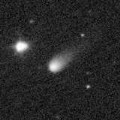
|
Now it is 13.1 mag (Oct. 20, Seiichi Yoshida). It is expected to brighten up to 7 mag in 2017 summer. In the Northern Hemisphere, it keeps observable in good condition until the highlight while the comet will be brightening. In the Southern Hemisphere, it is not observable until early 2017.
Date(TT) R.A. (2000) Decl. Delta r Elong. m1 Best Time(A, h)
Oct. 29 12 13.77 46 26.1 3.526 3.246 65 12.5 3:29 (231,-27)
Nov. 5 12 28.82 46 0.1 3.405 3.179 68 12.4 3:19 (231,-26)
|
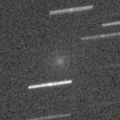
|
It approached to the Sun down to 0.45 a.u. on Oct. 10. It was 12.5-13.0 mag on Sept. 24 (Michael Jager). It will never be observable again in the Northern Hemisphere. In the Southern Hemisphere, it will appear in the evening sky at 14 mag soon, but it keeps extremely low after that. It has a very similar orbit to Comet C/1915 R1 ( Mellish ).
Date(TT) R.A. (2000) Decl. Delta r Elong. m1 Best Time(A, h)
Oct. 29 15 21.16 -19 34.8 1.509 0.633 17 12.4 19:59 ( 64, -1)
Nov. 5 15 55.22 -26 48.5 1.599 0.754 20 13.3 20:08 ( 58, 2)
|
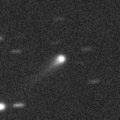
|
It brightened very rapidly and became brighter than expected. Now it is very bright as 12.5 mag (Oct. 25, Chris Wyatt). It will be unobservable in November in the Southern Hemisphere, or in December in the Northern Hemisphere.
Date(TT) R.A. (2000) Decl. Delta r Elong. m1 Best Time(A, h)
Oct. 29 17 7.62 -17 12.4 2.614 1.990 41 12.5 19:59 ( 81, 17)
Nov. 5 17 24.86 -17 9.9 2.662 1.994 39 12.6 20:08 ( 78, 13)
|

|
It brightened up to 6.2 mag in June (June 24, Marco Goiato). Now it is fading. It has already faded down to 13.3 mag (Sept. 28, Chris Wyatt). It it not observable now. In the Southern Hemisphee, it will appear in the morning sky in mid December, then it keeps observable in excellent condition. In the Northern Hemisphere, it will appear in the morning sky in late December, then it keeps low.
Date(TT) R.A. (2000) Decl. Delta r Elong. m1 Best Time(A, h)
Oct. 29 14 43.80 -28 52.8 3.842 2.906 16 12.6 19:59 ( 51, -3)
Nov. 5 14 47.42 -29 12.1 3.935 2.980 13 12.7 20:08 ( 46, -7)
|
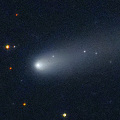
|
Now it is 12.9 mag (Oct. 20, Seiichi Yoshida). It will be getting higher gradually after this, but it will be fading.
Date(TT) R.A. (2000) Decl. Delta r Elong. m1 Best Time(A, h)
Oct. 29 10 37.18 -3 33.8 1.922 1.567 54 13.1 3:29 (261, 19)
Nov. 5 10 52.04 -5 55.4 1.914 1.606 56 13.3 3:19 (262, 21)
|
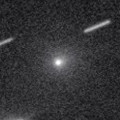
|
Now it is bright as 11.2 mag (Oct. 14, Thomas Lehmann). It keeps locating extremely low until November in the Southern Hemisphere.
Date(TT) R.A. (2000) Decl. Delta r Elong. m1 Best Time(A, h)
Oct. 29 11 16.02 1 26.5 2.087 1.577 46 13.6 3:29 (263, 8)
Nov. 5 11 32.77 -0 29.0 2.079 1.611 48 14.3 3:19 (264, 9)
|

|
Outburst occured on Oct. 21, and it brightened up to 13.8 mag (Jean-Francois Soulier). It is bright as 12.6 mag still now (Oct. 25, Chris Wyatt).
Date(TT) R.A. (2000) Decl. Delta r Elong. m1 Best Time(A, h)
Oct. 29 19 25.72 -24 9.1 6.093 5.892 73 13.7 19:59 ( 92, 49)
Nov. 5 19 29.30 -23 55.0 6.197 5.891 67 13.7 20:08 ( 88, 42)
|

|
It brightened up to 8-9 mag from winter to spring. Now it is fading. It has already faded down to 12.9 mag (July 23, Chris Wyatt). It will appear in the morning sky at 14 mag soon in the Northern Hemisphere, or in December in the Southern Hemisphere.
Date(TT) R.A. (2000) Decl. Delta r Elong. m1 Best Time(A, h)
Oct. 29 12 48.93 -2 38.3 4.992 4.101 23 13.7 3:29 (280, -9)
Nov. 5 12 53.38 -3 44.8 4.998 4.160 29 13.8 3:19 (278, -5)
|
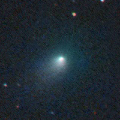
|
Now it is 13.5 mag (Oct. 5, Thomas Lehmann). It will be fading gradually after this. In the Northern Hemisphere, it keeps low after this. In the Southern Hemisphere, it will be getting lower after this, and it will be unobservable in December.
Date(TT) R.A. (2000) Decl. Delta r Elong. m1 Best Time(A, h)
Oct. 29 18 1.28 -29 60.0 2.133 1.758 54 13.8 19:59 ( 75, 34)
Nov. 5 18 23.12 -30 5.5 2.210 1.790 52 14.0 20:08 ( 73, 31)
|

|
It brightened up to 11 mag from spring to summer. Now it is not observable. It will be observable at 16 mag again in 2017 spring.
Date(TT) R.A. (2000) Decl. Delta r Elong. m1 Best Time(A, h)
Oct. 29 14 59.79 -14 49.0 2.833 1.869 11 13.9 19:59 ( 65, -9)
Nov. 5 15 17.61 -16 2.0 2.878 1.904 8 14.0 20:08 ( 61,-12)
|
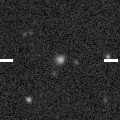
|
It will appear in the morning sky at 13 mag in December. It is expected to brighten up to 7 mag in 2017 spring. But it locates somewhat low at the high light. It was 16.4 mag in August (Aug. 12, Thomas Lehmann), the brightness evolution seemed to have slowed down.
Date(TT) R.A. (2000) Decl. Delta r Elong. m1 Best Time(A, h)
Oct. 29 13 12.95 -11 1.8 3.920 2.972 15 14.2 3:29 (290, -8)
Nov. 5 13 23.28 -11 58.7 3.810 2.892 19 14.0 3:19 (289, -6)
|
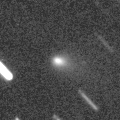
|
It had been lost for a long time over 200 years since its discovery in 1783. It brightened rapidly, and reached up to 13.9 mag in September (Spet. 1, Sandor Szabo). Now it is 14.5 mag (Oct. 5, Thomas Lehmann). It will be fading after this. It is observable in excellent condition for a while in the Northern Hemisphere. It will be unobservable in November in the Southern Hemisphere.
Date(TT) R.A. (2000) Decl. Delta r Elong. m1 Best Time(A, h)
Oct. 29 5 29.02 33 24.2 1.031 1.846 131 14.0 3:00 (180, 22)
Nov. 5 5 21.85 38 0.8 1.004 1.865 138 14.2 2:25 (180, 17)
|
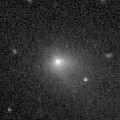
|
Now it is bright as 13.1 mag (Oct. 20, Seiichi Yoshida). Distant object, but it keeps observable at 13-14 mag for a long time from 2015 to 2016.
Date(TT) R.A. (2000) Decl. Delta r Elong. m1 Best Time(A, h)
Oct. 29 0 35.78 -4 26.8 4.128 5.011 149 14.1 22:03 (180, 59)
Nov. 5 0 34.51 -4 47.6 4.200 5.023 142 14.1 21:34 (180, 60)
|

|
It keeps unobservable for a long time. It will appear in the morning sky in December, when the comet will be fainter than 15 mag.
Date(TT) R.A. (2000) Decl. Delta r Elong. m1 Best Time(A, h)
Oct. 29 13 11.75 -11 47.8 2.607 1.669 15 14.3 3:29 (290, -8)
Nov. 5 13 30.87 -13 15.9 2.644 1.723 17 14.5 3:19 (292, -7)
|
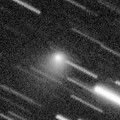
|
It brightened up to 11.6 mag from late August to early September (Aug. 29, Juan Jose Gonzalez). Now it is fading rapidly. It has already faded down to 15.6 mag (Oct. 22, E. Bryssinck). It will be low in November.
Date(TT) R.A. (2000) Decl. Delta r Elong. m1 Best Time(A, h)
Oct. 29 18 44.60 -13 46.6 2.211 2.014 65 14.6 19:59 ( 98, 35)
Nov. 5 18 44.07 -15 43.9 2.386 2.045 58 14.9 20:08 ( 90, 29)
|
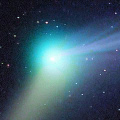
|
It brightened up to 6 mag from last autumn to last winter. Now it is fading. It has already faded down to 15.8 mag (Oct. 24, D. Buczynski). It is observable in good condition in the Northern Hemisphere. It is not observable after this in the Southern Hemisphere.
Date(TT) R.A. (2000) Decl. Delta r Elong. m1 Best Time(A, h)
Oct. 29 5 8.63 56 56.0 4.116 4.760 125 14.8 2:40 (180, -2)
Nov. 5 4 54.62 57 10.4 4.116 4.831 131 14.9 1:59 (180, -2)
|
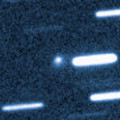
|
Now it is 15.4 mag (Oct. 9, Kunihiro Shima). It will brighten up to 14 mag from winter to spring in 2017, and it will be observable in excellent condition in the Northern Hemisphere. In the Southern Hemisphere, it keeps extremely low until November, and it will be low also around the higlight.
Date(TT) R.A. (2000) Decl. Delta r Elong. m1 Best Time(A, h)
Oct. 29 10 13.98 25 37.1 2.590 2.440 70 15.0 3:29 (234, 5)
Nov. 5 10 26.96 25 18.6 2.508 2.434 74 14.9 3:19 (234, 6)
|

|
Now it is 14.6 mag (Oct. 15, Ken-ichi Kadota). It will be fading gradually after this. It will be unobservable soon. But it will appear in the morning sky again at 16 mag in late December in the Northern Hemisphere, or in late January in the Southern Hemisphere.
Date(TT) R.A. (2000) Decl. Delta r Elong. m1 Best Time(A, h)
Oct. 29 16 4.72 7 16.3 4.349 3.574 34 14.9 19:59 ( 92, -9)
Nov. 5 16 10.79 5 47.3 4.435 3.620 30 15.1 20:08 ( 86,-15)
|

|
It has been lost since its discovery in 1978. In 2016, it is expected to return in excellent condition from autumn to winter.
Date(TT) R.A. (2000) Decl. Delta r Elong. m1 Best Time(A, h)
Oct. 29 21 11.01 -24 37.5 0.722 1.297 96 15.1 19:59 (117, 70)
Nov. 5 21 32.98 -22 19.9 0.734 1.289 95 15.1 20:08 (116, 66)
|
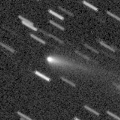
|
Now it is 15.0 mag (Oct. 13, Mt. Lemmon Survey). It will be observable at 15-16 mag in good condition from autumn to winter. It locates somewhat low in the Southern Hemisphere.
Date(TT) R.A. (2000) Decl. Delta r Elong. m1 Best Time(A, h)
Oct. 29 4 43.69 33 58.5 1.787 2.629 140 15.1 2:14 (180, 21)
Nov. 5 4 40.68 34 16.8 1.756 2.645 147 15.1 1:44 (180, 21)
|
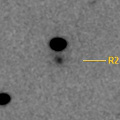
|
Now it is very bright as 15.6 mag (Sept. 11, Hidetaka Sato). It will be observable at 11 mag for a long time from 2017 to 2018. Now it is observable in excellent condition in the Southern Hemisphere. But it keeps low for a while in the Northern Hemisphere.
Date(TT) R.A. (2000) Decl. Delta r Elong. m1 Best Time(A, h)
Oct. 29 3 33.23 -41 33.9 5.343 5.929 122 15.4 1:04 ( 0, 83)
Nov. 5 3 28.13 -41 38.9 5.297 5.878 121 15.3 0:31 ( 0, 83)
|
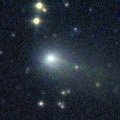
|
It brightened up to 12.5 mag in summer (Aug. 3, Marco Goiato). Now it is fading. It has already faded down to 14.3 mag (Oct. 23, Chris Wyatt). It keeps observable in good condition for a while.
Date(TT) R.A. (2000) Decl. Delta r Elong. m1 Best Time(A, h)
Oct. 29 21 15.04 -16 57.4 2.479 2.830 100 15.3 19:59 (132, 65)
Nov. 5 21 21.73 -16 37.8 2.597 2.857 94 15.5 20:08 (121, 60)
|
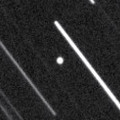
|
Now it is 14.9 mag (Sept. 29, Sandor Szabo). In the Northern Hemisphere, it keeps observable in excellent condition, but it will be fading after this. It keeps locating very low in the Southern Hemisphere.
Date(TT) R.A. (2000) Decl. Delta r Elong. m1 Best Time(A, h)
Oct. 29 22 27.41 44 22.4 0.635 1.442 123 15.6 19:59 (179, 11)
Nov. 5 22 37.82 37 46.8 0.739 1.522 122 16.0 20:08 (174, 17)
|
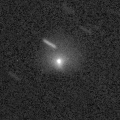
|
It has brightened in outburst up to 14 mag twice, in 2006 January and 2011 May. Third outburst occured on Aug. 28, and it brightened up to 14.8 mag (Aug. 30, Juan Jose Gonzalez). It is bright as 15.4 mag still now (Sept. 29, Sandor Szabo). It is observable in good condition for a while.
Date(TT) R.A. (2000) Decl. Delta r Elong. m1 Best Time(A, h)
Oct. 29 1 8.44 4 45.3 5.432 6.383 161 15.7 22:35 (180, 50)
Nov. 5 1 6.27 4 30.8 5.489 6.396 154 15.8 22:06 (180, 50)
|
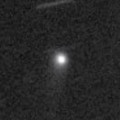
|
Now it is 15.8 mag (Oct. 22, E. Bryssinck). It will brighten up to 14 mag from summer to winter in 2017. Then it will be observable in excellent condition in the Northern Hemisphere. In the Southern Hemisphere, it is hardly observable around the highlight.
Date(TT) R.A. (2000) Decl. Delta r Elong. m1 Best Time(A, h)
Oct. 29 23 2.93 -14 22.7 3.742 4.390 125 15.8 20:30 (180, 69)
Nov. 5 22 58.25 -13 34.0 3.799 4.348 117 15.8 20:08 (173, 68)
|
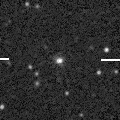
|
Now it is 16.5 mag (Oct. 22, E. Bryssinck). It will brighten up to 15 mag in winter. But it will be getting lower gradually after autumn.
Date(TT) R.A. (2000) Decl. Delta r Elong. m1 Best Time(A, h)
Oct. 29 21 55.23 -8 4.4 1.511 2.100 112 16.0 19:59 (161, 62)
Nov. 5 21 58.41 -7 13.3 1.550 2.062 106 15.9 20:08 (146, 58)
|
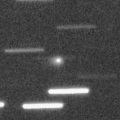
|
Now it is 15.8 mag (Oct. 23, Mt. Lemmon Survey). It will brighten up to 13 mag and will be observable in good condition in 2017 summer. In 2016, it keeps observable until winter when it will brighten up to 15.5 mag. It locates somewhat low in the Southern Hemisphere.
Date(TT) R.A. (2000) Decl. Delta r Elong. m1 Best Time(A, h)
Oct. 29 1 59.16 29 14.0 3.115 4.079 163 16.1 23:25 (180, 26)
Nov. 5 1 43.90 28 6.9 3.076 4.030 161 16.0 22:42 (180, 27)
|
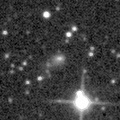
|
Now it is 17.3 mag (Oct. 11, J. Oey, P. Camilleri, H. Williams). It will be observable at 13 mag for a long time from 2017 to 2018. It will be unobservable temporarily in early November in the Southern Hemisphere, or in early December in the Northern Hemisphere.
Date(TT) R.A. (2000) Decl. Delta r Elong. m1 Best Time(A, h)
Oct. 29 18 31.13 -8 28.5 5.909 5.532 63 16.1 19:59 (101, 29)
Nov. 5 18 31.83 -8 17.8 5.973 5.491 56 16.1 20:08 ( 95, 22)
|
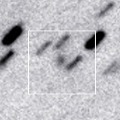
|
Now it is 17.2 mag (Oct. 22, C. Bell). It keeps 16-17 mag for a long time from 2016 to 2019. It keeps locating near by the equator.
Date(TT) R.A. (2000) Decl. Delta r Elong. m1 Best Time(A, h)
Oct. 29 9 18.01 2 3.9 9.928 9.718 74 16.2 3:29 (242, 30)
Nov. 5 9 19.60 1 55.3 9.811 9.711 81 16.2 3:19 (239, 34)
|
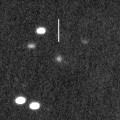
|
Now it is 17.0 mag (Oct. 25, D. Buczynski). It will be observable at 16 mag in good condition from autumn to winter. It locates low in the Southern Hemisphere.
Date(TT) R.A. (2000) Decl. Delta r Elong. m1 Best Time(A, h)
Oct. 29 7 29.96 24 16.1 3.465 3.849 105 16.4 3:29 (203, 27)
Nov. 5 7 31.72 24 23.9 3.359 3.841 111 16.3 3:19 (199, 28)
|
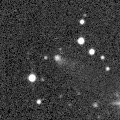
|
It brightened rapidly. Now it is 16.9 mag (Oct. 4, Mt. Lemmon Survey). It is observable at 16.5 mag in good condition from autumn to winter.
Date(TT) R.A. (2000) Decl. Delta r Elong. m1 Best Time(A, h)
Oct. 29 22 34.01 -10 4.2 2.030 2.676 120 16.6 20:02 (180, 65)
Nov. 5 22 35.54 -9 25.3 2.098 2.663 114 16.6 20:08 (162, 63)
|
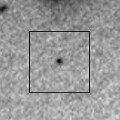
|
First return of a new periodic comet discovered in 2007. Now it is 19.4 mag (Sept. 1, K. Sarneczky, P. Szekely). It was expected to brighten up to 16.5 mag and will be observable in good condition from autumn to winter. But actually, it is fainter than predicted by 3 mag.
Date(TT) R.A. (2000) Decl. Delta r Elong. m1 Best Time(A, h)
Oct. 29 3 34.83 -13 53.5 1.501 2.391 146 16.7 1:06 (180, 69)
Nov. 5 3 29.99 -13 53.6 1.471 2.371 148 16.6 0:33 (180, 69)
|
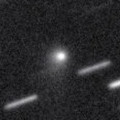
|
It brightened up to 15 mag in early 2016. Now it is fading. It has already faded down to 17.0 mag (Oct. 9, P. Carson). In the Northern Hemisphere, it keeps observable in good condition for a long time until 2017 autumn when the comet will be fainter than 18 mag. It will never be observable after this in the Southern Hemisphere.
Date(TT) R.A. (2000) Decl. Delta r Elong. m1 Best Time(A, h)
Oct. 29 13 33.13 66 48.3 6.019 5.938 80 16.6 3:29 (209,-41)
Nov. 5 13 46.45 66 27.8 6.006 5.963 82 16.6 3:19 (209,-41)
|
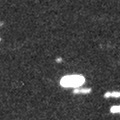
|
Now it is 16.5 mag (Oct. 24, D. Buczynski). It will brighten up to 15 mag and will be observable in good condition from autum to winter in 2017. In the Northern Hemisphere, it keeps observable in good condition for a long time while the comet will be brightening. It is not observable until 2017 summer in the Southern Hemisphere.
Date(TT) R.A. (2000) Decl. Delta r Elong. m1 Best Time(A, h)
Oct. 29 4 8.65 59 50.5 4.761 5.441 129 16.7 1:40 (180, -5)
Nov. 5 3 53.30 59 33.9 4.669 5.407 134 16.7 0:58 (180, -5)
|

|
Now it is 17.8 mag (Sept. 24, Kunihiro Shima). It will be getting higher after this, and it will be observable at 17 mag in good condition in winter.
Date(TT) R.A. (2000) Decl. Delta r Elong. m1 Best Time(A, h)
Oct. 29 11 7.35 4 54.3 2.747 2.238 49 16.7 3:29 (259, 8)
Nov. 5 11 19.31 3 55.9 2.705 2.263 53 16.7 3:19 (258, 10)
|
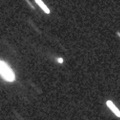
|
Now it is 16.7 mag (Oct. 3, A. Diepvens). It brightened rapidly, and became brighter than originally expected. It keeps 17 mag until 2017. In the Northern Hemisphere, it keeps observable in excellent condition for a long time. It is not observable in the Southern Hemisphere.
Date(TT) R.A. (2000) Decl. Delta r Elong. m1 Best Time(A, h)
Oct. 29 13 31.81 54 37.4 7.597 7.294 68 16.9 3:29 (225,-41)
Nov. 5 13 34.82 54 25.5 7.551 7.297 71 16.9 3:19 (225,-39)
|
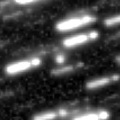
|
Now it is 17.9 mag (Oct. 3, B. Lutkenhoner, J. L. Tuten, K. Breedlove). It will brighten up to 16 mag and will be observable in good condition in 2017. In 2016, it is observable in excellent condition in the Southern Hemisphere, but it keeps low in the Northern Hemisphere.
Date(TT) R.A. (2000) Decl. Delta r Elong. m1 Best Time(A, h)
Oct. 29 19 19.45 -32 3.9 3.255 3.087 71 17.2 19:59 ( 80, 50)
Nov. 5 19 28.28 -31 20.2 3.329 3.072 66 17.2 20:08 ( 79, 45)
|
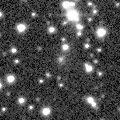
|
It will pass the perihelion in 2019. However, it has not been brightening since the discovery in 2010. Now it is 17.7 mag (Oct. 24, D. Buczynski). It keeps observable in excellent condition in the Northern Hemisphere. It is not observable in the Southern Hemisphere.
Date(TT) R.A. (2000) Decl. Delta r Elong. m1 Best Time(A, h)
Oct. 29 4 34.30 60 31.1 9.176 9.798 126 17.3 2:06 (180, -6)
Nov. 5 4 30.52 60 56.6 9.103 9.778 130 17.2 1:34 (180, -6)
|
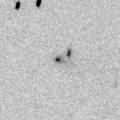
|
Now it is 17.2 mag (Oct. 21, Mt. Lemmon Survey). It tends to be brightest after the perihelion passage. It is observable at 17.5 mag in good condition from autumn to winter.
Date(TT) R.A. (2000) Decl. Delta r Elong. m1 Best Time(A, h)
Oct. 29 2 24.85 0 6.8 2.111 3.085 166 17.3 23:51 (180, 55)
Nov. 5 2 20.36 -0 15.5 2.132 3.095 163 17.3 23:19 (180, 55)
|
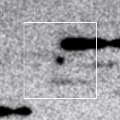
|
Appearing in the morning sky. It keeps 16 mag for a long time from 2017 to 2018.
Date(TT) R.A. (2000) Decl. Delta r Elong. m1 Best Time(A, h)
Oct. 29 9 49.41 -12 23.0 6.421 6.056 64 17.4 3:29 (262, 33)
Nov. 5 9 49.93 -12 22.2 6.291 6.032 70 17.3 3:19 (259, 37)
|
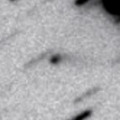
|
It was observed at 17 mag last winter. It will be observable at 17 mag again next winter. Now it is 18.1 mag (Sept. 24, Kunihiro Shima). It is observable in good condition in the Northern Hemisphere. But it locates low in the Southern Hemisphere.
Date(TT) R.A. (2000) Decl. Delta r Elong. m1 Best Time(A, h)
Oct. 29 10 39.36 13 30.2 4.178 3.773 59 17.4 3:29 (248, 8)
Nov. 5 10 46.33 14 2.3 4.094 3.787 65 17.3 3:19 (245, 10)
|
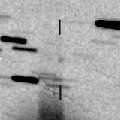
|
First return of a new periodic comet discovered in 2005. Now it is 18.2 mag (Oct. 24, D. Buczynski). In the Northern Hemisphere, it will be observable at 17 mag in excellent condition in winter. It locates somewhat low in the Southern Hemisphere.
Date(TT) R.A. (2000) Decl. Delta r Elong. m1 Best Time(A, h)
Oct. 29 3 56.67 23 50.5 1.896 2.821 153 17.4 1:28 (180, 31)
Nov. 5 3 53.04 23 36.0 1.863 2.821 161 17.4 0:56 (180, 31)
|
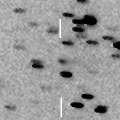
|
Now it is 17.2 mag (Oct. 25, D. Buczynski). In the Northern Hemisphere, it will be observable at 17 mag in excellent condition in winter. It locates low in the Southern Hemisphere.
Date(TT) R.A. (2000) Decl. Delta r Elong. m1 Best Time(A, h)
Oct. 29 7 15.08 32 30.0 2.922 3.385 109 17.4 3:29 (197, 20)
Nov. 5 7 18.01 32 45.8 2.835 3.386 115 17.4 3:19 (194, 21)
|
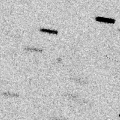
|
Now it is 18.4 mag (Oct. 9, Kunihiro Shima). In the Northern Hemisphere, it is observable at 17.5 mag in excellent condition from autumn to winter. It keeps extremely low in the Southern Hemisphere.
Date(TT) R.A. (2000) Decl. Delta r Elong. m1 Best Time(A, h)
Oct. 29 9 32.74 31 17.1 2.156 2.225 80 17.4 3:29 (224, 7)
Nov. 5 9 45.89 31 40.8 2.095 2.239 85 17.4 3:19 (223, 7)
|
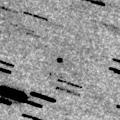
|
Now it is 17.7 mag (Oct. 22, D. Buczynski). It will pass the perihelion on Mar. 10, 2017. In the Northern Hemisphere, it keeps observable in the evening sky until late February while the comet will be brightening up to 8.5 mag. In the Southern Hemisphere, it will appear in the morning sky in late March at 8 mag, then it keeps observable while the comet will be fading.
Date(TT) R.A. (2000) Decl. Delta r Elong. m1 Best Time(A, h)
Oct. 29 23 26.59 9 55.2 1.301 2.152 138 17.4 20:53 (180, 45)
Nov. 5 23 15.83 8 36.3 1.304 2.080 129 17.4 20:15 (180, 46)
|
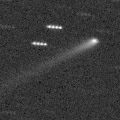
|
It brightened up to 15 mag from late 2014 to early 2016. Now it is fading slowly. Now it is 17.1 mag (Oct. 23, C. Bell). In the Northern Hemisphere, it will be observable at 16-17 mag in autumn in good condition. It locates extremely low in the Southern Hemisphere.
Date(TT) R.A. (2000) Decl. Delta r Elong. m1 Best Time(A, h)
Oct. 29 21 30.16 37 53.2 4.946 5.414 113 17.4 19:59 (167, 16)
Nov. 5 21 25.80 36 50.8 5.059 5.449 108 17.5 20:08 (159, 14)
|
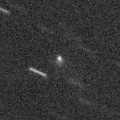
|
Now it is 17.7 mag (Oct. 20, J.-F. Soulier, C. Rinner, F. Kugel, J. Nicolas). It will be observable at 17.5 mag in good condition in autumn.
Date(TT) R.A. (2000) Decl. Delta r Elong. m1 Best Time(A, h)
Oct. 29 22 51.18 1 6.4 1.665 2.411 128 17.4 20:19 (180, 54)
Nov. 5 22 53.57 0 56.8 1.714 2.392 121 17.5 20:08 (174, 54)
|
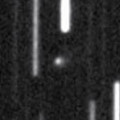
|
Now it is 17.7 mag (Oct. 22, CAO, San Pedro de Atacama). It keeps 17 mag for a long time from 2016 autumn to 2017 summer, and it keeps observable good condition all through that period in the Southern Hemisphere. In the Northern Hemisphere, it will be unobservable soon, then it will never be observable again.
Date(TT) R.A. (2000) Decl. Delta r Elong. m1 Best Time(A, h)
Oct. 29 4 39.00 -48 29.9 2.235 2.741 110 17.6 2:09 ( 0, 77)
Nov. 5 4 27.96 -52 22.4 2.234 2.712 108 17.6 1:31 ( 0, 73)
|

|
Now it is 17.3 mag (Oct. 24, D. Buczynski). It keeps observable at 17.5 mag in good condition from autumn to winter.
Date(TT) R.A. (2000) Decl. Delta r Elong. m1 Best Time(A, h)
Oct. 29 3 34.40 17 33.3 2.130 3.083 160 17.7 1:05 (180, 37)
Nov. 5 3 30.30 17 7.9 2.101 3.078 168 17.7 0:34 (180, 38)
|

|
Peculiar asteroid with a comet-like orbit. It is observable at 18 mag in good condition in October.
Date(TT) R.A. (2000) Decl. Delta r Elong. m1 Best Time(A, h)
Oct. 29 2 30.21 -16 57.1 2.008 2.907 149 17.8 0:02 (180, 72)
Nov. 5 2 17.31 -20 29.3 2.054 2.911 143 17.9 23:16 (180, 76)
|
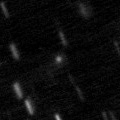
|
Now it is 17.8 mag (Oct. 15, J. Oey, P. Camilleri, H. Williams). It keeps 17 mag for a long time in 2016, and it will be observable in excellent condition in the Southern Hemisphere. It is hardly observable in the Northern Hemisphere.
Date(TT) R.A. (2000) Decl. Delta r Elong. m1 Best Time(A, h)
Oct. 29 0 5.60 -48 10.6 3.254 3.743 112 17.8 21:32 ( 0, 77)
Nov. 5 23 51.82 -46 25.5 3.358 3.771 107 17.9 20:51 ( 0, 79)
|
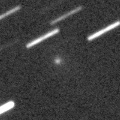
|
First return of a new periodic comet which brightened up to 16.5 mag in 2008. The condition of this apparition is very good. It was expected to brighten up to 15.5 mag in autumn and will be observable in good condition. But actually, it is 17.8 mag (Oct. 22, E. Bryssinck), fainter than originally expected by 2-3 mag.
Date(TT) R.A. (2000) Decl. Delta r Elong. m1 Best Time(A, h)
Oct. 29 23 19.67 -6 49.8 1.521 2.309 132 18.0 20:47 (180, 62)
Nov. 5 23 17.85 -5 20.3 1.584 2.305 125 18.1 20:18 (180, 60)
|
|
![]()
 56P/Slaughter-Burnham
56P/Slaughter-Burnham C/2016 R2 ( PanSTARRS )
C/2016 R2 ( PanSTARRS ) 53P/Van Biesbroeck
53P/Van Biesbroeck (3200) Phaethon
(3200) Phaethon 174P/(60558) 2000 EC98 ( Echeclus )
174P/(60558) 2000 EC98 ( Echeclus ) C/2016 N4 ( MASTER )
C/2016 N4 ( MASTER ) 93P/Lovas 1
93P/Lovas 1 C/2015 VL62 ( Lemmon-Yeung-PanSTARRS )
C/2015 VL62 ( Lemmon-Yeung-PanSTARRS ) C/2015 O1 ( PanSTARRS )
C/2015 O1 ( PanSTARRS ) C/2014 B1 ( Schwartz )
C/2014 B1 ( Schwartz ) 74P/Smirnova-Chernykh
74P/Smirnova-Chernykh 188P/LINEAR-Mueller
188P/LINEAR-Mueller P/2016 R1 ( Catalina )
P/2016 R1 ( Catalina ) C/2013 V4 ( Catalina )
C/2013 V4 ( Catalina ) C/2015 V1 ( PanSTARRS )
C/2015 V1 ( PanSTARRS ) 118P/Shoemaker-Levy 4
118P/Shoemaker-Levy 4 C/2014 R3 ( PanSTARRS )
C/2014 R3 ( PanSTARRS ) 47P/Ashbrook-Jackson
47P/Ashbrook-Jackson C/2010 U3 ( Boattini )
C/2010 U3 ( Boattini ) 136P/Mueller 3
136P/Mueller 3 C/2016 A1 ( PanSTARRS )
C/2016 A1 ( PanSTARRS ) C/2015 X7 ( ATLAS )
C/2015 X7 ( ATLAS ) P/2016 Q1 ( Read )
P/2016 Q1 ( Read ) P/2015 TP200 ( LINEAR )
P/2015 TP200 ( LINEAR ) 33P/Daniel
33P/Daniel 2P/Encke
2P/Encke C/2014 A4 ( SONEAR )
C/2014 A4 ( SONEAR ) 343P/2016 P3 ( NEAT-LONEOS )
343P/2016 P3 ( NEAT-LONEOS ) C/2016 S1 ( PanSTARRS )
C/2016 S1 ( PanSTARRS ) 128P/Shoemaker-Holt 1
128P/Shoemaker-Holt 1 2016 PN66
2016 PN66 C/2015 B2 ( PanSTARRS )
C/2015 B2 ( PanSTARRS ) 338P/2016 N1 ( McNaught )
338P/2016 N1 ( McNaught )![]()
















































